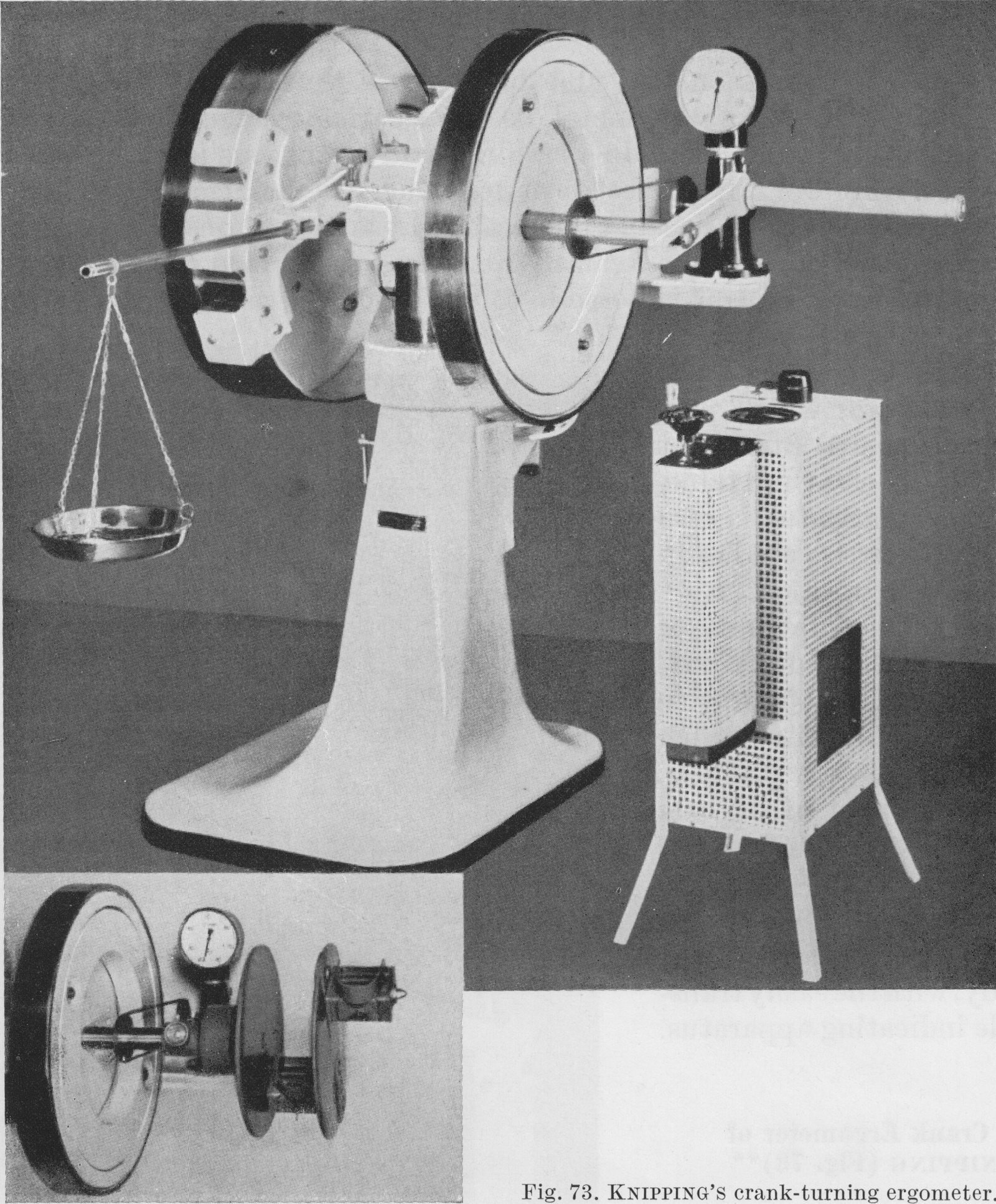
From “Methods in pulmonary physiology”, by Bertels H, Bucherl E, Hertz CW, Rodewald G, Schwab M. Translated by Workman JM. Hafner Publishing Co., 1963, page 104. Manufactured by Dargatz.

From “Methods in pulmonary physiology”, by Bertels H, Bucherl E, Hertz CW, Rodewald G, Schwab M. Translated by Workman JM. Hafner Publishing Co., 1963, page 104. Manufactured by Dargatz.
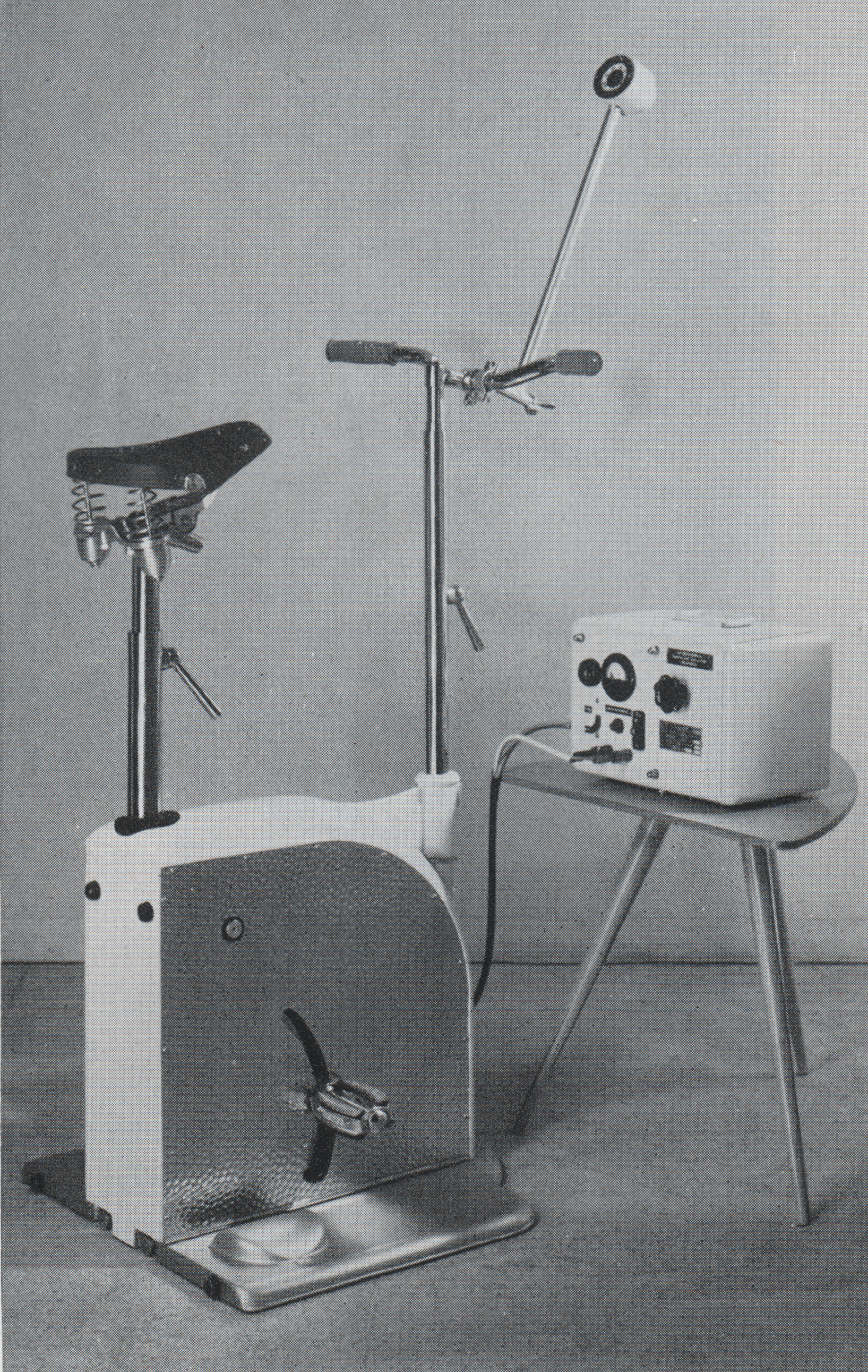
From “Methods in pulmonary physiology”, by Bertels H, Bucherl E, Hertz CW, Rodewald G, Schwab M. Translated by Workman JM. Hafner Publishing Co., 1963, page 103.
“This ergometer works on the same principle as that of Benedict. Her also braking is applied to a rotating metal disc by a variable magnetic field. Work can be done either on footpedals or a crank. An advantageous feature is the taking over the start of work by an electric motor which switches itself off automatically.”
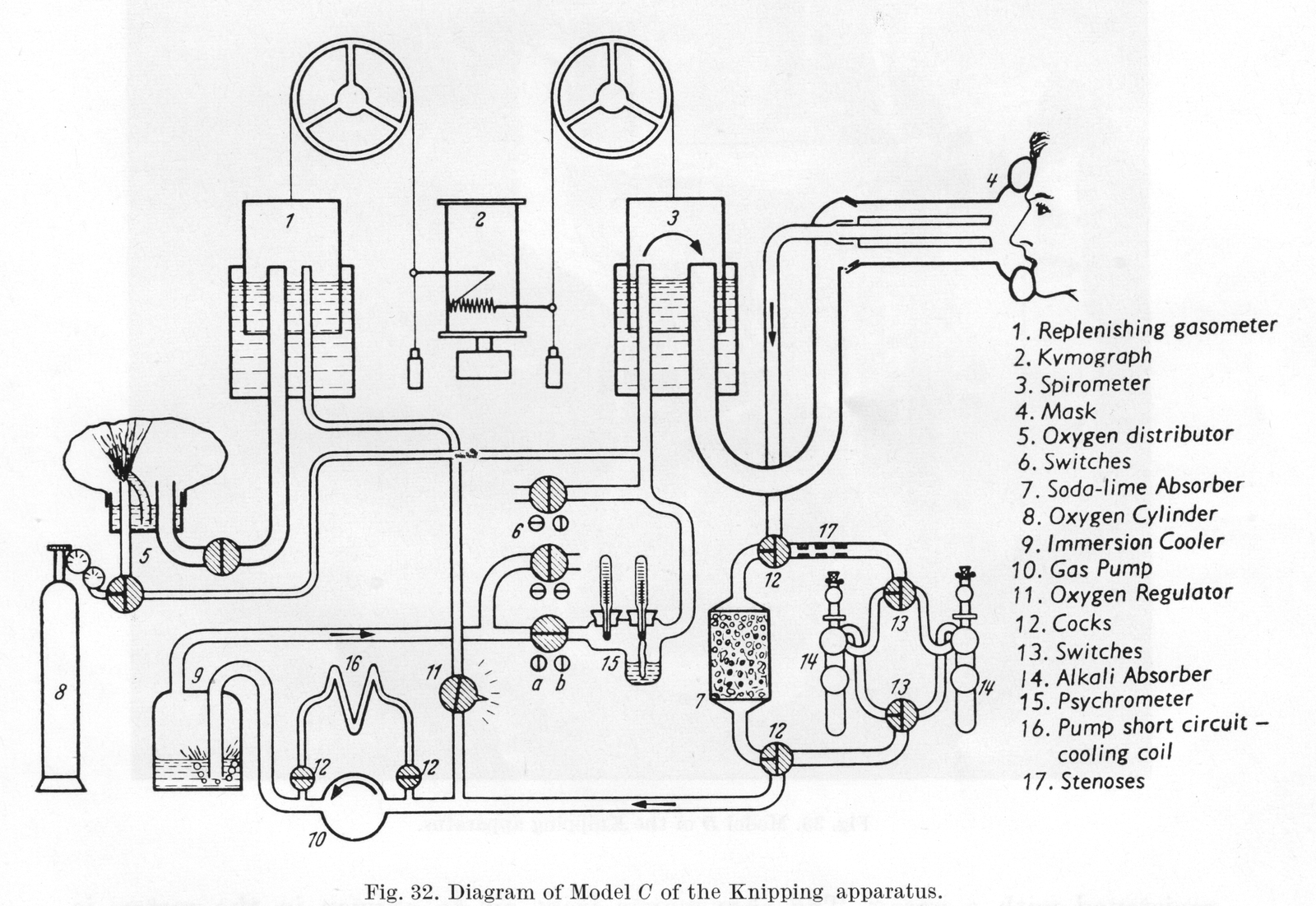
From “Methods in pulmonary physiology”, by Bertels H, Bucherl E, Hertz CW, Rodewald G, Schwab M. Translated by Workman JM. Hafner Publishing Co., 1963, page 31. Undated, but probably from around 1950.
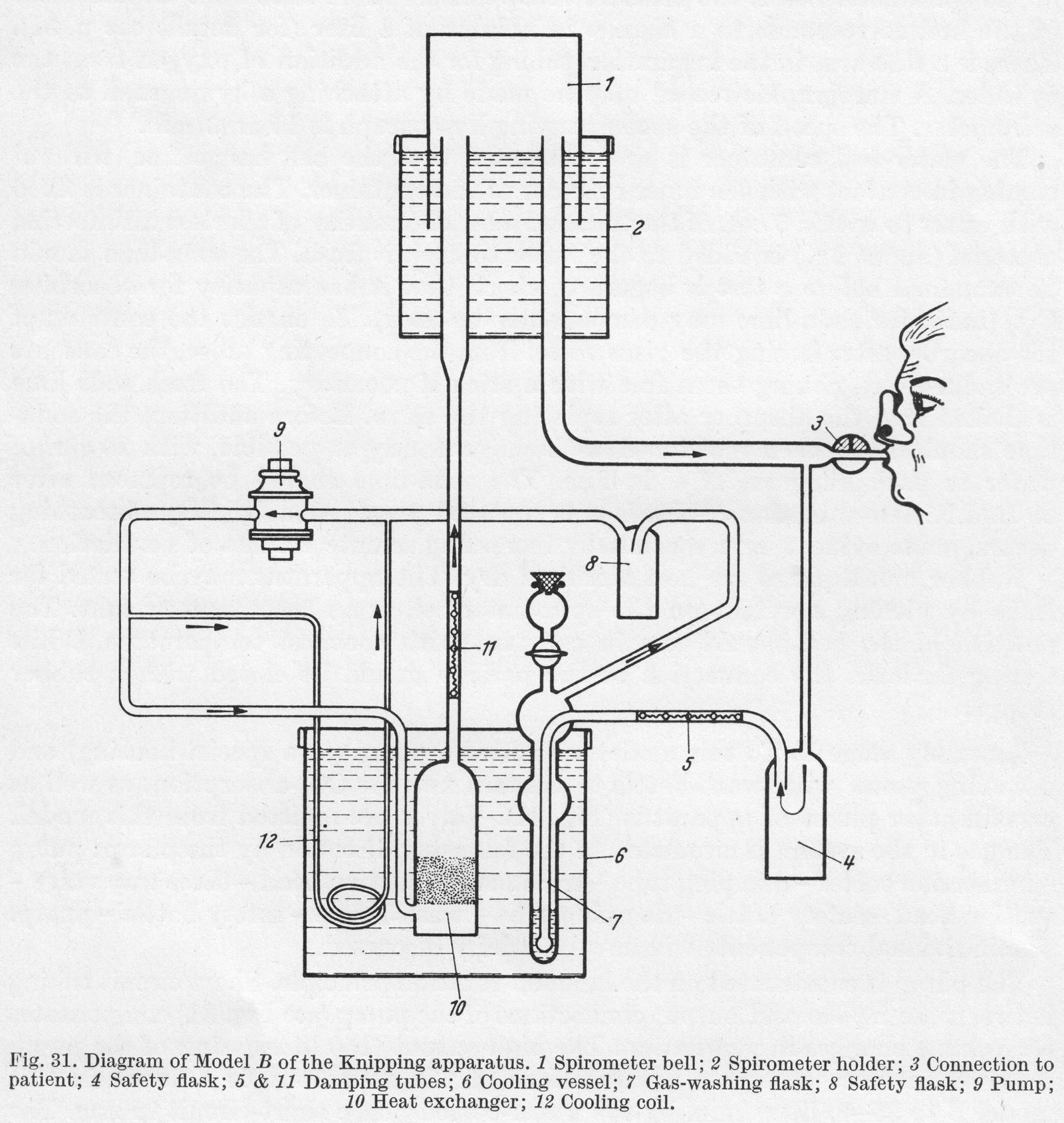
From “Methods in pulmonary physiology”, by Bertels H, Bucherl E, Hertz CW, Rodewald G, Schwab M. Translated by Workman JM. Hafner Publishing Co., 1963, page 30. Undated, but probably from the mid-1930’s.
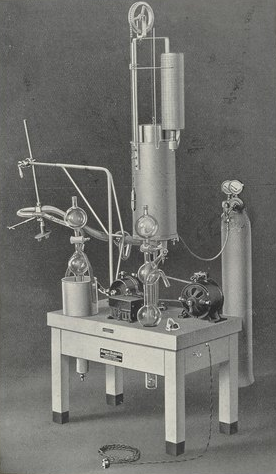
From “The gas metabolism apparatus according to Dr. Knipping. Its application and treatment.”, by Albert Dargatz, published 1927 in Hamberg, Germany.
From Palmer, C. F. 1934. Palmer Research and Students’ Apparatus for Physiology, Pharmacology, Psychology, Bacteriology, Phonetics, Botany, etc.: Manufactured by C. F. Palmer (London) Ltd., Myographic Works, 63a, Effra Road, Brixton, London, S.W. 2. England, page 87.
“With this instrument working on the principle used by Prof. Knipping, it is possible to show on the same record, in addition to the volume of oxygen consumed, the volume of C.O2 produced.
“Also by using a rotary air pump to ventilate the apparatus, no valves are necessary.
“Dimensions and features of the spirometer itself and the recording cylinder are identical to those given for No. E150.
“The air circulating pump is substantially made and fitted with a water jacket for cooling; this should be connected to the nearest water supply. Lubricating points in the pump are conveniently placed, and should receive occasional attention.
“The electric motor is quiet running, and has ample power. Two model of this spirometer are made. In one, No. E165, the recording cylinder is driven by a clockwork movement making one revolution in 20 minutes. In the other, No. E166, the recording cylinder is driven from the motor, this enables a two-speed gear to be used, so the the cylinder can be run at a faster rate (1 revolution in 2 minutes) in addition to the normal speed of one revolution in 20 minutes.”
From Palmer, C. F. 1934. Palmer Research and Students’ Apparatus for Physiology, Pharmacology, Psychology, Bacteriology, Phonetics, Botany, etc.: Manufactured by C. F. Palmer (London) Ltd., Myographic Works, 63a, Effra Road, Brixton, London, S.W. 2. England, page 88.
“The several parts of the assembly as shown in the outline drawing herewith, consist of the following: —
“1. The Spirometer A, the float of which is carefully balanced by a chain comensated counterpoise.
“2. The rotary air pump P, works on the centrifugal principle, and is driven by the electric motor M.
“3. The glas flask F contains the K.O.H. solution in the bottom, depending into this is a tube with a perforated bulb at one end, so that air from the pump is forced through the solution and to the outlet in the side. At the top of the flask is a container for the H2SO4, which is released through the cock C, when it is desired to ascertain the C.O2 produced.
“4. The three-way cock T.C. is used to connect the subject at the mouthpiece H, to the apparatus, or to the outside air O.
“5. The “U” tube S.V. containing water, acts as a safety valve in the circuit.
“6. The recording cylinder D carries the calibrated record charts W being the ink writing pen.
“Very briefly the circulation system is as follows: Gas is from from the Spirometer A, which has previously been charged with oxygen, into the Pump P, and foced from there down the centre tube of the flask F, and through the K.O.H. where the C.O2 produced is absorbed, and so to the three-way cock T.C, and the mouthpiece H, from thence it returns through the safety valve S.V. to the Spirometer A. The reduction in volume due to the amount of oxygen consumed, is registered by the ink pen W, on the calibrated chart affixed to the recording cylinder D.
“On order to ascertain the amount of C.O2 produced, the subject at the mouthpiece H should be disconnected from the apparatus by the three-way cock TC, the air should continue to be circulated in the apparatus until the pen W records a horizontal line. The H2SO4 is then run slowly into the K.O.H in the flask F, through the cock C. Cooling is effected by the water in a cylindrical tank around the outside of the flask.
“The action of the H2SO4 on the K.O.H. causes the C.O2 absorbed to be given off, and so the float of the Spirometer rises, the amount being recorded by the ink pen W.
“The foregoing is only a very simple description of the method of using the apparatus; before actual records are taken with subjects, further information should be obtained from a competent authority.”
Photo found at esport.dshs-koeln.de. Exercise testing using a hand-cranked electrically braked ergometer. Spirometer is described as closed-circuit Knipping Model 210 D, manufactured by Dargatz, a German company.